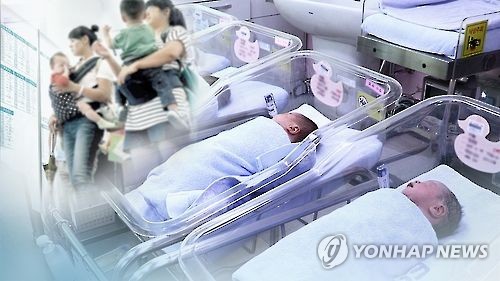South Korea's birthrate began to tumble in the mid-1980s in line with an increase in the number of married women receiving higher levels of education, a report said Wednesday.
The country's total fertility rate -- the average number of children a woman bears in her lifetime -- plunged to 1.6 in 1987 from the replacement level of 2.1 three years earlier, according to the report by the Korea Institute for Health and Social Affairs.
 |
(Yonhap) |
South Korea suffered a nosedive almost at the same time as the number of married women aged between 15 and 49 with high school diplomas outstripped those of middle school graduates.
People with middle school diplomas accounted for 30.2 percent of all married women in South Korea in 1985, with the portion of high school graduates reaching 25.9 percent. The numbers came to 28.5 percent and 31.1 percent, respectively, three years later.
"The findings show South Korean women's marriage and birth patterns are closely related to the level of their educational background," the report said.
In 1974, slightly over 70 percent of South Korea's married women aged 15-49 were elementary school graduates, but nearly 95 percent of them had high school or university diplomas in 2012.
The report also showed married women's labor force participation rate had also surged in line with their higher educational backgrounds over the cited period. About 39 percent of all married women were inside the labor force in 1974 with the ratio jumping to 53 percent in 2012.
South Korea has one of the lowest birthrates in the world. Its total fertility rate stood at 1.24 in 2015, far lower than the replacement level of 2.1 that would keep South Korea's population of 51 million stable. (Yonhap)




![[Herald Interview] 'Trump will use tariffs as first line of defense for American manufacturing'](http://res.heraldm.com/phpwas/restmb_idxmake.php?idx=644&simg=/content/image/2024/11/26/20241126050017_0.jpg)

![[Health and care] Getting cancer young: Why cancer isn’t just an older person’s battle](http://res.heraldm.com/phpwas/restmb_idxmake.php?idx=644&simg=/content/image/2024/11/26/20241126050043_0.jpg)

